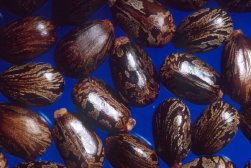Ricin Fact Sheet
|
Ricin is a potent toxin that could be used as an agent of biological warfare or bioterrorism. It is a phytotoxalbumin protein derived from the beans of the castor plant (Ricinus communis). Ricin is widely available and easily produced. Ricin's significance as a potential bioweapon relates in part to its availability. Although ricin is not an ideal bioweapon agent, it remains a threat. Delivery: Ricin can be delivered via inhalation, injection, or ingestion. Liquid or crystalline ricin could be utilized as a food or water contaminant. For ricin to be delivered as an aerosol, it must be lyophilized-a process by which a liquid substance is dried by freezing in a high vacuum. While it is not overly difficult to aerosolize ricin, this step does present a technical challenge. Production: Ricin can be produced relatively easily and inexpensively in large quantities in a fairly low-technology setting. Worldwide, one million tons of castor beans are processed annually in the production of castor oil; the waste mash from this process is 5-10% ricin by weight. Historic Use: Ricin has reportedly been used as a tool for assassinations. During the 1980's Iran-Iraq war, ricin may have been used. In February 2004, ricin was detected in mail received at the U.S. Senate office complex. |
Effects: Fever, coughing, and gastrointestinal problems are likely to be the first symptoms. If eaten, the toxin causes stomach irritation, gastroenteritis, bloody diarrhea, and vomiting. Inhalation causes severe lung damage, including pulmonary edema. It can
Treatment: There is no treatment or prophylaxis currently available for ricin exposure. If exposure does not prove fatal within 3-5 days, the victim will usually recover. |
|||||
(Sources: Scotland Yard, CDC, U.S. Army, eMedicine.com) |
||||||



